


Henry Havelock & India Campaign (c) Fitzwilliam Museum
A museum as august and decorous as the Fitzwilliam in Cambridge provides the perfect setting for the critical practice of an artist like Matt Smith. Renowned for its fine collections of Venetian painting, as well as maiolica and important examples of ancient art from across the globe, the museum is not only a treasure house, but redolent of all the venerable intellectual authority of the university, of which it is a part. With its Greek temple architecture, and acres of marble and polished wood, one feels all of these things simply walking through the front doors.
Matt Smith was a curator before training in ceramics at City Lit in London. He worked at the Victoria & Albert Museum, Science Museum and BFI before adopting a direction that would lead to a PhD focusing on ceramics and the creation of queer identity. Now his practice embraces curating as well as work in ceramics and textiles and in recent years he has devised solo and group interventions into the collections at Birmingham Museum and Art Gallery (Queering the Museum, 2010) and a number of National Trust properties (Unravelling the National Trust, 2012).
His hero, Smith has said, is the African American artist Fred Wilson, whose 1992 exhibition Mining the Museum at the Maryland Historical Society has become a key event in the history of critical museology. Historical distance creates a kind of carapace over objects – a hard shell of orthodox narrative that is steadily condensed as the object recedes from living memory into that place called “the past”. Inconvenient truths struggle to survive this process, and the complexities of historical context tend to fall away.
In his exhibition Flux: Parian unpacked, Smith has activated what is, on the face of it, a slightly dull collection of parian portrait busts that were donated to the museum in 2016 from the G D V Glynn estate, in lieu of Inheritance Tax. As a material, parian was a Victorian invention, designed to mimic marble and make it possible for the middle classes to collect statuary, and their heroes, in their own homes. With the exception of Queen Victoria, the majority of these figures are unrecognisable to a contemporary audience.
In the Octagon Gallery on the first floor, Smith has created a visually arresting installation, centred on a stack of packing crates that function as a display system for a mass of these portrait busts. The walls of the gallery are papered with brilliantly coloured toile de jouy, on which smaller groups of busts are arranged. Reminiscent of the satirical strategy of Glasgow based designers Timorous Beasties, these wallpapers use historical cartoons and photography to reveal the horrors that are the unspoken CVs of these eminent Victorians.
In repeating pattern of fuchsia pink against a café au lait ground, a turbaned sepoy is strapped to the barrel of a cannon, awaiting a grisly and theatrical execution for his part in the first Indian Uprising of 1858. This was on the orders of Sir Henry Havelock, then Adjutant-General of India, whose equestrian statue is in Trafalgar Square. As a child, Smith spent several years living and being schooled in Brazil. “I was taught Brazilian history. I heard how European countries ruthlessly exploited other countries economically. To the ears of someone who had been educated in England, it was literally unbelievable”. This early experience of history’s mutability sensitised Smith to the power and responsibility of the storyteller, not only in the past but right now. In the exhibition publication he quotes from a current Home Office publication designed to help people through their Life in the UK test: “…there was, for the most part, an orderly transition from Empire to Commonwealth, with countries being granted their independence.”
On adjacent walls other inglorious episodes from British imperial history are played out. The Opium Wars of the mid 1800s feature, with Field Marshall Colin Campbell’s bust sitting against cartoon scenes of gun-toting Jack Tars, Chinese junks and skeletons carrying crates of opium. Sir Robert Peel and William Gladstone are lined up against the Great Famine of Ireland (1845-49); Field Marshalls Herbert Kitchener and John French are singled out for their ‘scorched earth policy’ during the Second Boer War (1899-1902).
There is a growing movement to ‘decolonise the museum’ in this way, The work of Sarah Wajid’s Museum Detox group being a powerful agent in this area. Sadiah Qureshi’s excellent essay in the exhibition publication forthrightly lays out the arguments for it. “It is not enough for museums to simply add depictions of people of colour, or new works by people of colour to their galleries. (…) on its own, inclusion will do nothing to change the overall narratives that museums present to the public. (…) In contrast, decolonisation involves radically rethinking the overall narratives museums use to display their collections.”
Matt Smith’s interventions in the museum extend beyond the Octagon Gallery, using his highly recognisable ‘collaged’ ceramics to respond to the collections. Sometimes his responses are purely visual, but elsewhere they direct thoughts to the difference between his authored works and the work of anonymous crafts people responsible for historic objects, or the continuities between moulding techniques in the quite separate disciplines of bronze and ceramics.
The artist’s broader curatorial intent however is summed up in his written statement: “During the last eighteen months, Britain has been in flux in a way that I have never seen. Many people have insisted on partial and fixed views of what ‘makes’ Britain. The collection of parian ware provides a similarly partial and fixed view of history. The truth is always more complex, nuanced and inclusive.”
Caroline Douglas
Director
The Fitzwilliam Museum, Trumpington Street, Cambridge CB2 1RB. Tuesday - Saturday, 10.00 - 17.00, Sundays and Bank Holidays 12.00 - 17.00. Exhibition continues until 1 July 2018. www.fitzmuseum.cam.ac.uk